University Reflective Journal: Sustainability Related Business Issues
VerifiedAdded on 2023/01/19
|6
|1287
|43
Journal and Reflective Writing
AI Summary
This reflective journal explores the multifaceted concept of sustainability within the business context, drawing upon insights from course materials and discussions. The journal delves into various aspects of sustainability, including the triple bottom line, the six forms of capital, and the six phases of business approaches to sustainability. It examines how businesses can integrate sustainable practices, considering economic, environmental, and social factors. The journal emphasizes the importance of measuring performance, understanding economic and natural capital, and the role of human and social capital. It analyzes the different strategies businesses employ to address sustainability, from rejecting it to fully internalizing sustainability values. The conclusion highlights that becoming sustainable is an ongoing process that requires self-analysis, innovation, and risk-taking.
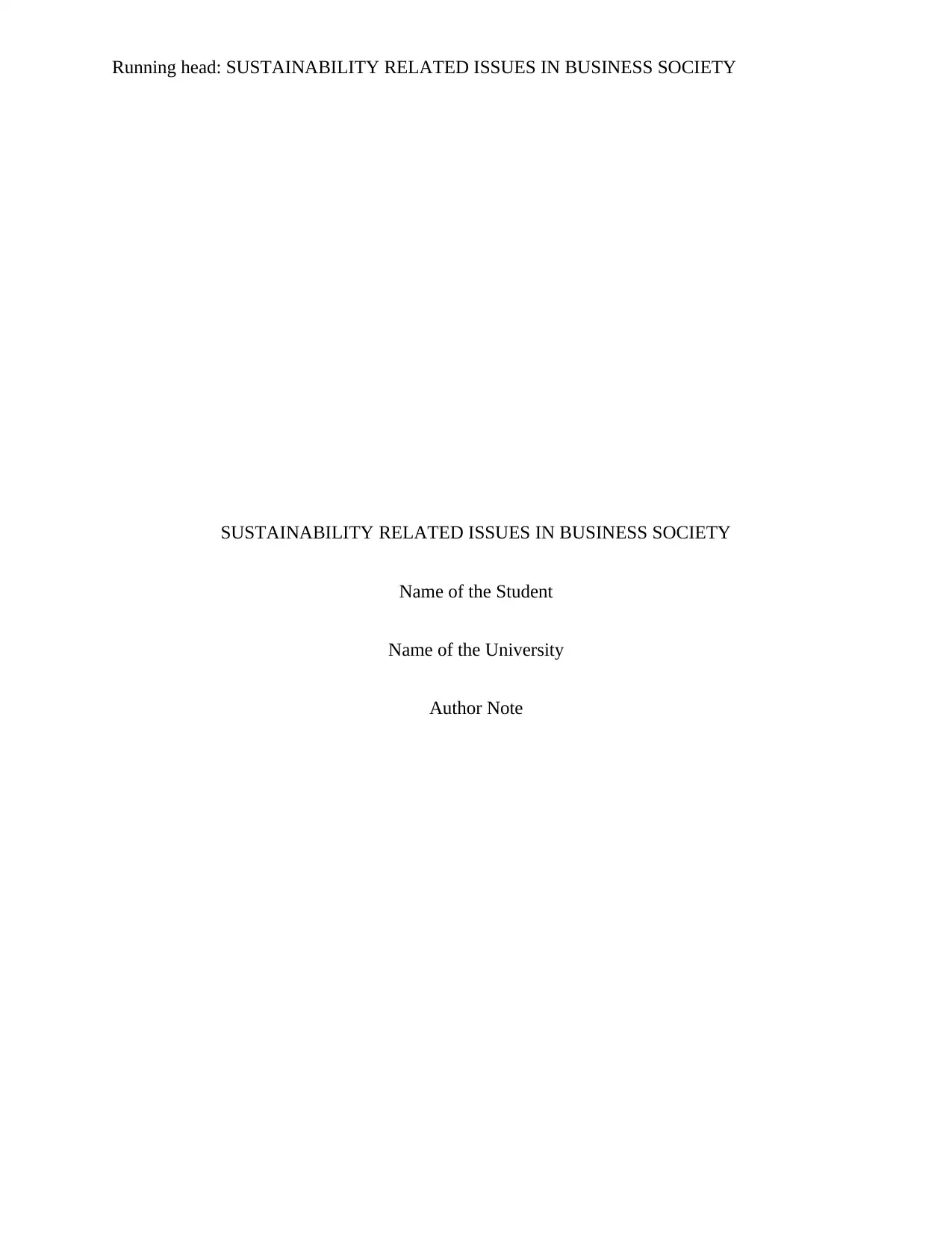
Running head: SUSTAINABILITY RELATED ISSUES IN BUSINESS SOCIETY
SUSTAINABILITY RELATED ISSUES IN BUSINESS SOCIETY
Name of the Student
Name of the University
Author Note
SUSTAINABILITY RELATED ISSUES IN BUSINESS SOCIETY
Name of the Student
Name of the University
Author Note
Paraphrase This Document
Need a fresh take? Get an instant paraphrase of this document with our AI Paraphraser
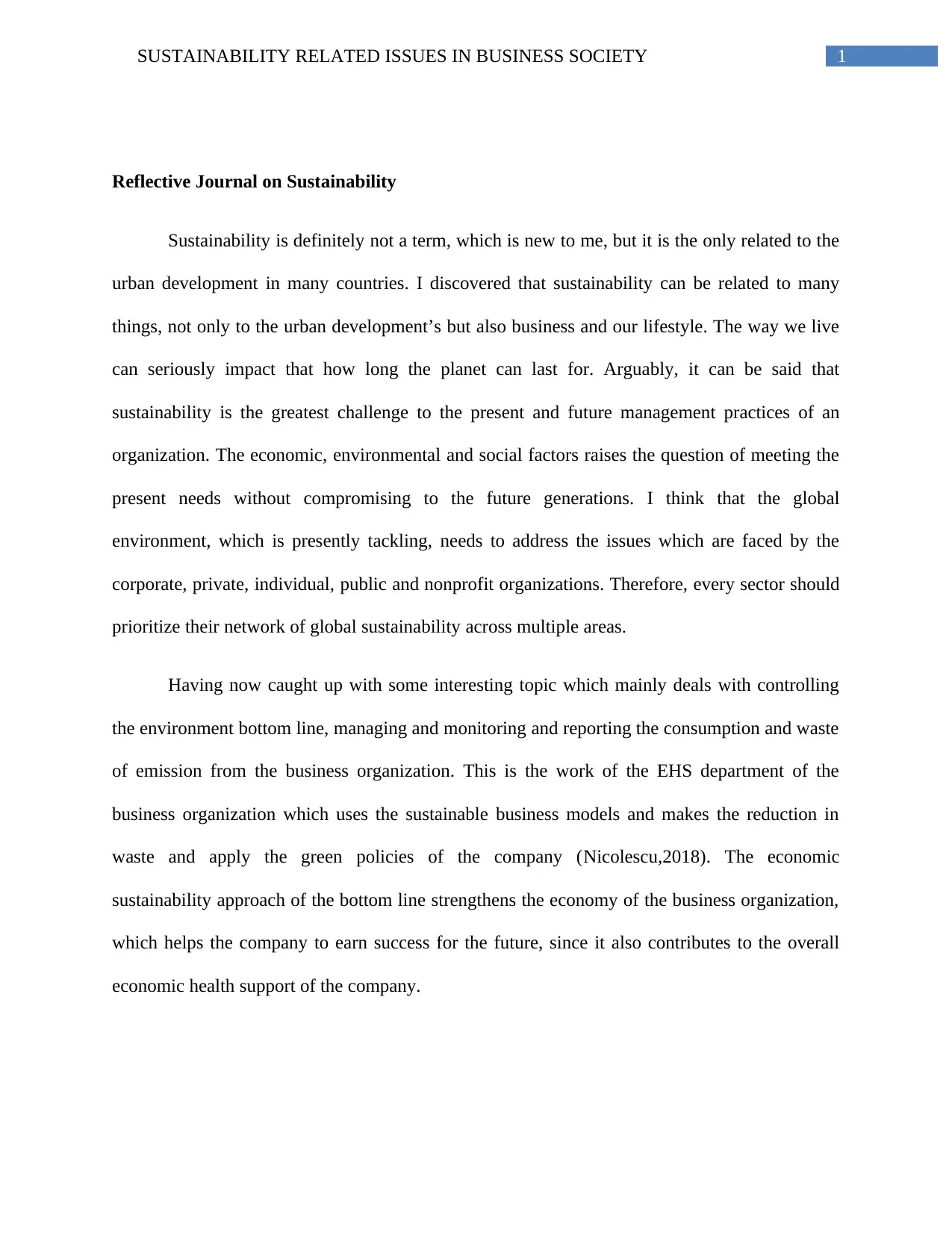
1SUSTAINABILITY RELATED ISSUES IN BUSINESS SOCIETY
Reflective Journal on Sustainability
Sustainability is definitely not a term, which is new to me, but it is the only related to the
urban development in many countries. I discovered that sustainability can be related to many
things, not only to the urban development’s but also business and our lifestyle. The way we live
can seriously impact that how long the planet can last for. Arguably, it can be said that
sustainability is the greatest challenge to the present and future management practices of an
organization. The economic, environmental and social factors raises the question of meeting the
present needs without compromising to the future generations. I think that the global
environment, which is presently tackling, needs to address the issues which are faced by the
corporate, private, individual, public and nonprofit organizations. Therefore, every sector should
prioritize their network of global sustainability across multiple areas.
Having now caught up with some interesting topic which mainly deals with controlling
the environment bottom line, managing and monitoring and reporting the consumption and waste
of emission from the business organization. This is the work of the EHS department of the
business organization which uses the sustainable business models and makes the reduction in
waste and apply the green policies of the company (Nicolescu,2018). The economic
sustainability approach of the bottom line strengthens the economy of the business organization,
which helps the company to earn success for the future, since it also contributes to the overall
economic health support of the company.
Reflective Journal on Sustainability
Sustainability is definitely not a term, which is new to me, but it is the only related to the
urban development in many countries. I discovered that sustainability can be related to many
things, not only to the urban development’s but also business and our lifestyle. The way we live
can seriously impact that how long the planet can last for. Arguably, it can be said that
sustainability is the greatest challenge to the present and future management practices of an
organization. The economic, environmental and social factors raises the question of meeting the
present needs without compromising to the future generations. I think that the global
environment, which is presently tackling, needs to address the issues which are faced by the
corporate, private, individual, public and nonprofit organizations. Therefore, every sector should
prioritize their network of global sustainability across multiple areas.
Having now caught up with some interesting topic which mainly deals with controlling
the environment bottom line, managing and monitoring and reporting the consumption and waste
of emission from the business organization. This is the work of the EHS department of the
business organization which uses the sustainable business models and makes the reduction in
waste and apply the green policies of the company (Nicolescu,2018). The economic
sustainability approach of the bottom line strengthens the economy of the business organization,
which helps the company to earn success for the future, since it also contributes to the overall
economic health support of the company.
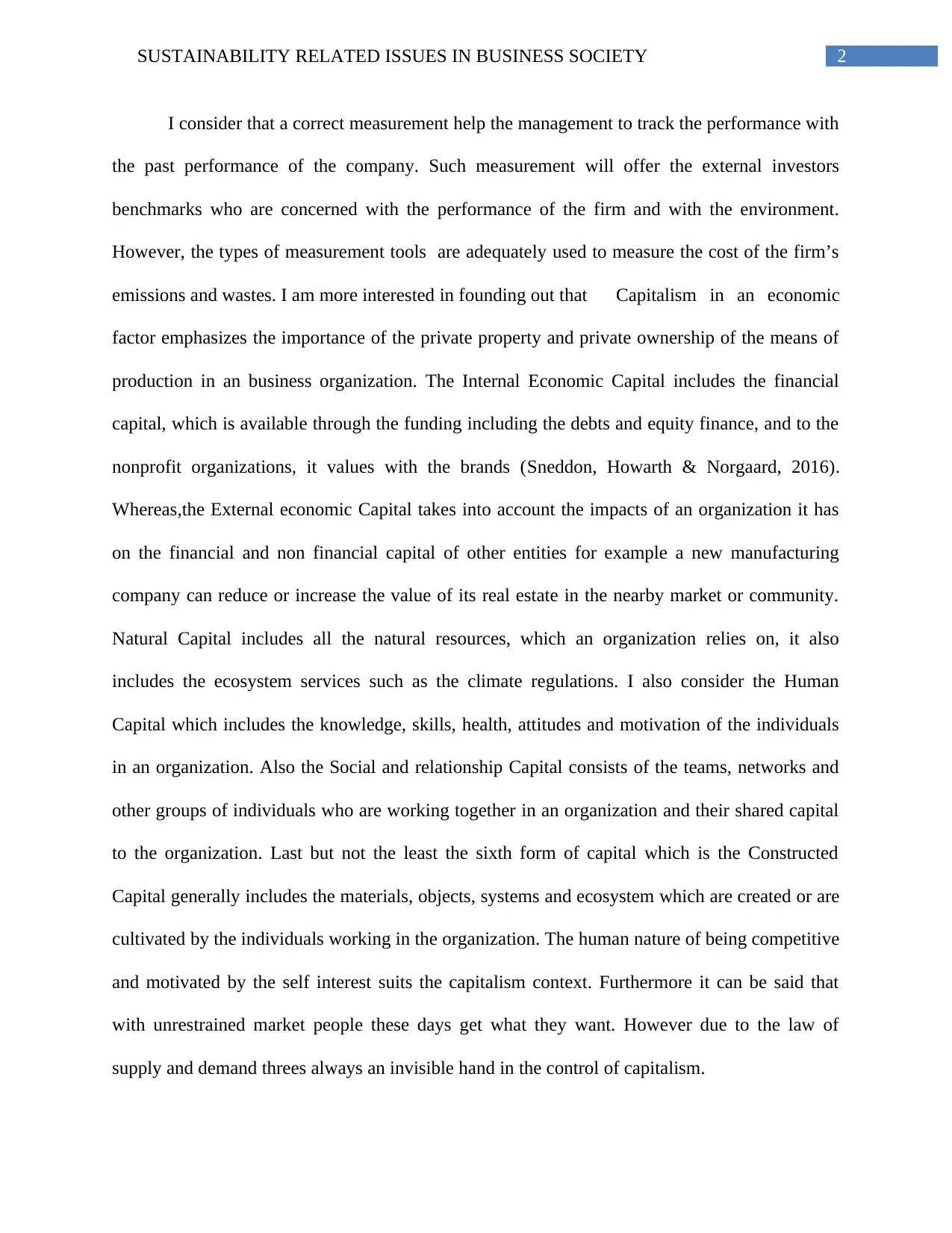
2SUSTAINABILITY RELATED ISSUES IN BUSINESS SOCIETY
I consider that a correct measurement help the management to track the performance with
the past performance of the company. Such measurement will offer the external investors
benchmarks who are concerned with the performance of the firm and with the environment.
However, the types of measurement tools are adequately used to measure the cost of the firm’s
emissions and wastes. I am more interested in founding out that Capitalism in an economic
factor emphasizes the importance of the private property and private ownership of the means of
production in an business organization. The Internal Economic Capital includes the financial
capital, which is available through the funding including the debts and equity finance, and to the
nonprofit organizations, it values with the brands (Sneddon, Howarth & Norgaard, 2016).
Whereas,the External economic Capital takes into account the impacts of an organization it has
on the financial and non financial capital of other entities for example a new manufacturing
company can reduce or increase the value of its real estate in the nearby market or community.
Natural Capital includes all the natural resources, which an organization relies on, it also
includes the ecosystem services such as the climate regulations. I also consider the Human
Capital which includes the knowledge, skills, health, attitudes and motivation of the individuals
in an organization. Also the Social and relationship Capital consists of the teams, networks and
other groups of individuals who are working together in an organization and their shared capital
to the organization. Last but not the least the sixth form of capital which is the Constructed
Capital generally includes the materials, objects, systems and ecosystem which are created or are
cultivated by the individuals working in the organization. The human nature of being competitive
and motivated by the self interest suits the capitalism context. Furthermore it can be said that
with unrestrained market people these days get what they want. However due to the law of
supply and demand threes always an invisible hand in the control of capitalism.
I consider that a correct measurement help the management to track the performance with
the past performance of the company. Such measurement will offer the external investors
benchmarks who are concerned with the performance of the firm and with the environment.
However, the types of measurement tools are adequately used to measure the cost of the firm’s
emissions and wastes. I am more interested in founding out that Capitalism in an economic
factor emphasizes the importance of the private property and private ownership of the means of
production in an business organization. The Internal Economic Capital includes the financial
capital, which is available through the funding including the debts and equity finance, and to the
nonprofit organizations, it values with the brands (Sneddon, Howarth & Norgaard, 2016).
Whereas,the External economic Capital takes into account the impacts of an organization it has
on the financial and non financial capital of other entities for example a new manufacturing
company can reduce or increase the value of its real estate in the nearby market or community.
Natural Capital includes all the natural resources, which an organization relies on, it also
includes the ecosystem services such as the climate regulations. I also consider the Human
Capital which includes the knowledge, skills, health, attitudes and motivation of the individuals
in an organization. Also the Social and relationship Capital consists of the teams, networks and
other groups of individuals who are working together in an organization and their shared capital
to the organization. Last but not the least the sixth form of capital which is the Constructed
Capital generally includes the materials, objects, systems and ecosystem which are created or are
cultivated by the individuals working in the organization. The human nature of being competitive
and motivated by the self interest suits the capitalism context. Furthermore it can be said that
with unrestrained market people these days get what they want. However due to the law of
supply and demand threes always an invisible hand in the control of capitalism.
⊘ This is a preview!⊘
Do you want full access?
Subscribe today to unlock all pages.

Trusted by 1+ million students worldwide
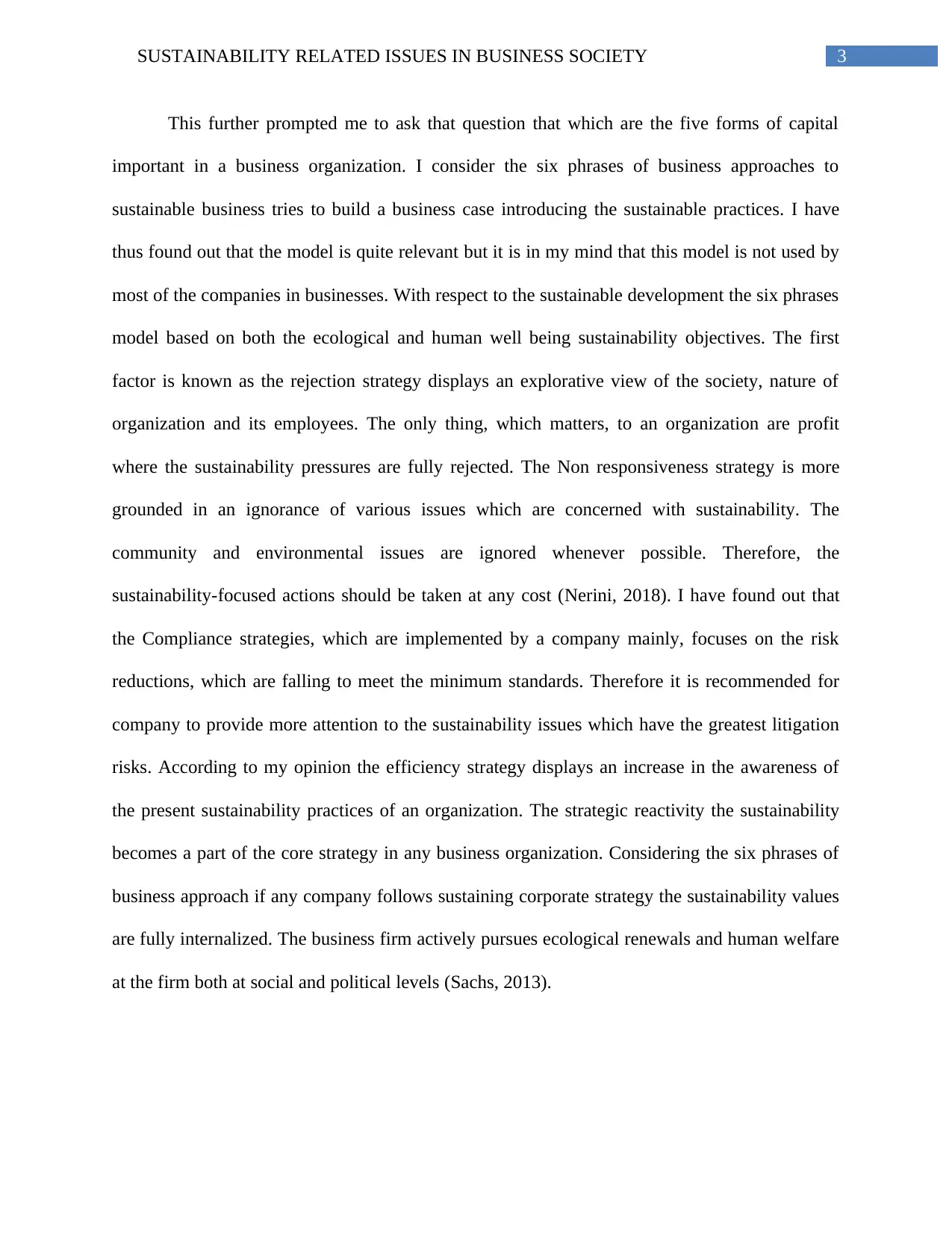
3SUSTAINABILITY RELATED ISSUES IN BUSINESS SOCIETY
This further prompted me to ask that question that which are the five forms of capital
important in a business organization. I consider the six phrases of business approaches to
sustainable business tries to build a business case introducing the sustainable practices. I have
thus found out that the model is quite relevant but it is in my mind that this model is not used by
most of the companies in businesses. With respect to the sustainable development the six phrases
model based on both the ecological and human well being sustainability objectives. The first
factor is known as the rejection strategy displays an explorative view of the society, nature of
organization and its employees. The only thing, which matters, to an organization are profit
where the sustainability pressures are fully rejected. The Non responsiveness strategy is more
grounded in an ignorance of various issues which are concerned with sustainability. The
community and environmental issues are ignored whenever possible. Therefore, the
sustainability-focused actions should be taken at any cost (Nerini, 2018). I have found out that
the Compliance strategies, which are implemented by a company mainly, focuses on the risk
reductions, which are falling to meet the minimum standards. Therefore it is recommended for
company to provide more attention to the sustainability issues which have the greatest litigation
risks. According to my opinion the efficiency strategy displays an increase in the awareness of
the present sustainability practices of an organization. The strategic reactivity the sustainability
becomes a part of the core strategy in any business organization. Considering the six phrases of
business approach if any company follows sustaining corporate strategy the sustainability values
are fully internalized. The business firm actively pursues ecological renewals and human welfare
at the firm both at social and political levels (Sachs, 2013).
This further prompted me to ask that question that which are the five forms of capital
important in a business organization. I consider the six phrases of business approaches to
sustainable business tries to build a business case introducing the sustainable practices. I have
thus found out that the model is quite relevant but it is in my mind that this model is not used by
most of the companies in businesses. With respect to the sustainable development the six phrases
model based on both the ecological and human well being sustainability objectives. The first
factor is known as the rejection strategy displays an explorative view of the society, nature of
organization and its employees. The only thing, which matters, to an organization are profit
where the sustainability pressures are fully rejected. The Non responsiveness strategy is more
grounded in an ignorance of various issues which are concerned with sustainability. The
community and environmental issues are ignored whenever possible. Therefore, the
sustainability-focused actions should be taken at any cost (Nerini, 2018). I have found out that
the Compliance strategies, which are implemented by a company mainly, focuses on the risk
reductions, which are falling to meet the minimum standards. Therefore it is recommended for
company to provide more attention to the sustainability issues which have the greatest litigation
risks. According to my opinion the efficiency strategy displays an increase in the awareness of
the present sustainability practices of an organization. The strategic reactivity the sustainability
becomes a part of the core strategy in any business organization. Considering the six phrases of
business approach if any company follows sustaining corporate strategy the sustainability values
are fully internalized. The business firm actively pursues ecological renewals and human welfare
at the firm both at social and political levels (Sachs, 2013).
Paraphrase This Document
Need a fresh take? Get an instant paraphrase of this document with our AI Paraphraser

4SUSTAINABILITY RELATED ISSUES IN BUSINESS SOCIETY
Conclusion
In order to conclude the above research paper it can be concluded that we have to keep in mind
that there is no easy step in approaching and becoming sustainable. Sustainability is a continuous
process, which requires critical self analysis, honesty, innovation and risk.
Conclusion
In order to conclude the above research paper it can be concluded that we have to keep in mind
that there is no easy step in approaching and becoming sustainable. Sustainability is a continuous
process, which requires critical self analysis, honesty, innovation and risk.
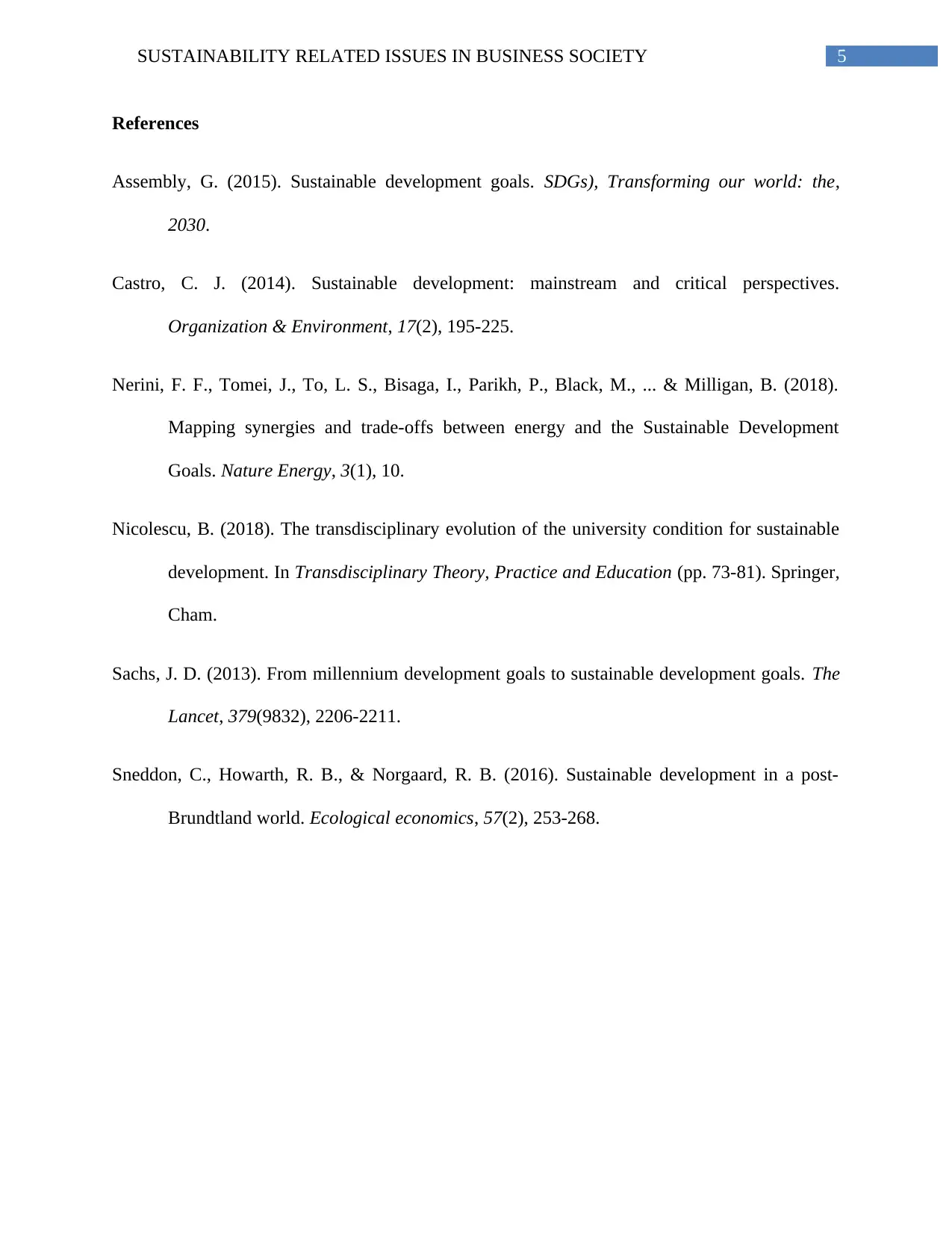
5SUSTAINABILITY RELATED ISSUES IN BUSINESS SOCIETY
References
Assembly, G. (2015). Sustainable development goals. SDGs), Transforming our world: the,
2030.
Castro, C. J. (2014). Sustainable development: mainstream and critical perspectives.
Organization & Environment, 17(2), 195-225.
Nerini, F. F., Tomei, J., To, L. S., Bisaga, I., Parikh, P., Black, M., ... & Milligan, B. (2018).
Mapping synergies and trade-offs between energy and the Sustainable Development
Goals. Nature Energy, 3(1), 10.
Nicolescu, B. (2018). The transdisciplinary evolution of the university condition for sustainable
development. In Transdisciplinary Theory, Practice and Education (pp. 73-81). Springer,
Cham.
Sachs, J. D. (2013). From millennium development goals to sustainable development goals. The
Lancet, 379(9832), 2206-2211.
Sneddon, C., Howarth, R. B., & Norgaard, R. B. (2016). Sustainable development in a post-
Brundtland world. Ecological economics, 57(2), 253-268.
References
Assembly, G. (2015). Sustainable development goals. SDGs), Transforming our world: the,
2030.
Castro, C. J. (2014). Sustainable development: mainstream and critical perspectives.
Organization & Environment, 17(2), 195-225.
Nerini, F. F., Tomei, J., To, L. S., Bisaga, I., Parikh, P., Black, M., ... & Milligan, B. (2018).
Mapping synergies and trade-offs between energy and the Sustainable Development
Goals. Nature Energy, 3(1), 10.
Nicolescu, B. (2018). The transdisciplinary evolution of the university condition for sustainable
development. In Transdisciplinary Theory, Practice and Education (pp. 73-81). Springer,
Cham.
Sachs, J. D. (2013). From millennium development goals to sustainable development goals. The
Lancet, 379(9832), 2206-2211.
Sneddon, C., Howarth, R. B., & Norgaard, R. B. (2016). Sustainable development in a post-
Brundtland world. Ecological economics, 57(2), 253-268.
⊘ This is a preview!⊘
Do you want full access?
Subscribe today to unlock all pages.

Trusted by 1+ million students worldwide
1 out of 6
Related Documents
Your All-in-One AI-Powered Toolkit for Academic Success.
+13062052269
info@desklib.com
Available 24*7 on WhatsApp / Email
![[object Object]](/_next/static/media/star-bottom.7253800d.svg)
Unlock your academic potential
Copyright © 2020–2025 A2Z Services. All Rights Reserved. Developed and managed by ZUCOL.




